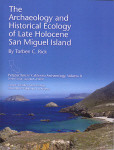Google Books previews are unavailable because you have chosen to turn off third party cookies for enhanced content. Visit our cookies page to review your cookie settings.
The Archaeology and Historical Ecology of Late Holocene San Miguel Island (Paperback)
Imprint: Cotsen Institute of Archaeology Press
Series: Perspectives in California Archaeology
Pages: 200
ISBN: 9781931745369
Published: 12th June 2007
Script Academic & Professional
Series: Perspectives in California Archaeology
Pages: 200
ISBN: 9781931745369
Published: 12th June 2007
Script Academic & Professional
You'll be £10.00 closer to your next £10.00 credit when you purchase The Archaeology and Historical Ecology of Late Holocene San Miguel Island. What's this?
+£4.99 UK Delivery or free UK delivery if order is over £40
(click here for international delivery rates)
Order within the next 1 hour, 13 minutes to get your order processed the next working day!
Need a currency converter? Check XE.com for live rates
(click here for international delivery rates)
Order within the next 1 hour, 13 minutes to get your order processed the next working day!
Need a currency converter? Check XE.com for live rates
California's northern Channel Islands have one of the longest and best preserved archaeological records in the Americas, spanning some 13,000 calendar years. When European explorers first travelled to the area the Chumash, some of the most populous and culturally complex hunter-gatherers known, inhabited these islands. Chumash society was characterised by hereditary leaders, sophisticated exchange networks and interaction spheres, and diverse maritime economies. Focusing on the archaeology of five sites dated to the last 3,000 years, this book examines the archaeology and historical ecology of San Miguel Island, the westernmost and most isolated of the northern Channel Islands. Detailed faunal, artefact, and other data are woven together in a diachronic analysis that investigates the interplay of social and ecological developments on this unique island. The first to focus solely on San Miguel Island archaeology, this book examines issues ranging from coastal adaptations to emergent cultural complexity to historical ecology and human impacts on ancient environments.
Other titles in the series...










